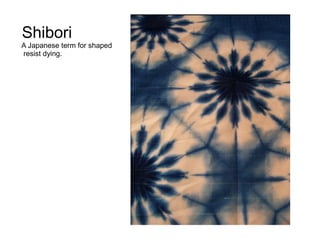
Shiborisp13
- 1. Shibori A Japanese term for shaped resist dying. Jacob Magraw
- 2. -The word is derived from the Japanese root verb shiboru, which means to “wring, squeeze, press” -The basic technique of Shibori is to draw a design on a piece of fabric (usually silk or cotton), then to tie very tight knots and when they are untied there is a pattern of dyed and undyed areas. -Shibori entered Japan around 1300 years ago from China, along with the Chinese style of dress, and was interpreted in a particularly Japanese fashion. -Traditionally, shibori was created by dyeing fabric in a fermented indigo vat. Indigo has a long history in Africa, China, Japan and India, where it is recorded in four thousand year old Sanskrit documents. Egyptian Pharaohs buried their dead in indigo dyed cloth. -Shibori was originally an art of the poor in peasant Japan. The art of Shibori evolved as a means of making old clothes look new.
- 3. -The Japanese shibori dyer works in concert with the material, not in effort to overcome its limitations. An element of the unexpected is always present. - Motohiko Katano (1889-1975), a painter turned dyer, created a body of sublime shibori work using indigo and other natural dyes ka ta no s hibo ri (ita jim e ) by Maotohiko Katano
- 4. Three terms for separate shibori methods have come into international usage: Plangi is a Malay-Indonesian word for the process of gathering and binding cloth. Bandhani is an Indian term for the process of plucking and binding cloth in small points. Tritik is a Malay-Indonesian word for stitch resist.
- 5. Techniques
- 7. -Can vary the amount of binding used to resist the fabric, which is pulled and gathered in hornlike units. -Can be tied by hand or with the use of a tool. (We will use chopsticks.) -Artisans improved the technique by developing a tool that hooks a point on the cloth, and pulls it into a cone shape while a thread is mechanically wound around it.
- 9. Use ALL of your might without breaking the threads to tighten up, scrunching your piece into a tiny, tight mass. Otherwise, the dye will be able to seep in and you won't get a clear pattern. Tie the thread ends together, holding tightly. Be careful not to let it loosen up while tying.
- 12. ORI-NUI “Teeth”
- 13. - Ori Nui is a type of stitch resist, characterized by its toothlike pattern. - The fabric below is pleated for Ori Nui and is stitched by hand with a running stitch close to the fold. - This type of stitch lets you make linear designs.
- 14. -Pull up the threads very tightly! Make a double knot where you begin and leave about 3 inches of loose thread where you end.
- 16. For the maki-nui pattern, the cloth is folded. Along the fold, and through both layers, insert the needle. Bring the point of needle back over the fold, wrapping the fold with the thread. (This is a whip-stitch.) Insert the needle again through both layers and wrap again. It doesn't matter if you wrap clock-wise or counter-clock wise, just be consistent.
- 18. For the mokume pattern, draw parallel lines 1/4" apart. With the needle, make big running stitches. To get the wavy look, avoid aligning stitches vertically - the stitches should be offset, like bricks.
- 19. Itijame
- 20. Itajime Shibori is created by pleating, folding, clamping and dyeing the fabric and it can be used to create repeat patterns. Each pleat is pressed down as it is made. The pleated strip of fabric can be folded into a series of right triangles each stacked on top of the others, pressing each fold as it is made. A stack of squares can be used with the same pressing method. Once the fabric is folded into stacks it can be tightly clamped between two identical pieces of wood, plexiglass, or heavy card stock.
- 21. Another method is to fold the cloth and then bind only the corners of the fabric with rubber bands. Then, wet the fabric and apply the dye.
- 22. Arashi “storm”
- 23. Arashi (Japanese for “storm”) shibori a pole-wrapping technique. The cloth is wrapped on a diagonal around a pole or cylindrical object and then tightly bound by wrapping thread or wire up and down the pole. Next, the cloth is scrunched down on the pole. The patterns are on a diagonal in arashi shibori which suggests the rain from a heavy storm.
- 24. -Roll dry fabric on pipe on the diagonal. -Create a loop and tie around base.You can also tape end of string on pole. -Wrap about half an inch, and scrunch down every 6-8 times. -Be careful not to bind to tightly, or the cloth will not slide down the tube. -Can immerse pole with fabric in the dye bath.
- 25. Dye can also be applied through brushing directly onto the fabric with a brush.
- 26. Arashi Ombre
- 27. Rust Dyeing
- 28. You can place rusty objects next to wet fabric and acquire rust patterning over time. However, vinegar will speed up the rusting process, it aids in breaking the rust particles free from the object that is rusting. Rusting occurs normally due to oxidation, i.e. contact with the air. Rust dyeing with water takes about a week. Using vinegar produces color in less time usually twenty-four hours. Natural fibers take the rust colors better than synthetic fibers.
- 30. Upstate
- 31. Yasuko Iyanaga AG ift fro m the Se a
- 32. Junichi Arai
- 33. Sara Paquette
- 35. Kevin O' Brian
- 36. Britt Rynearson
